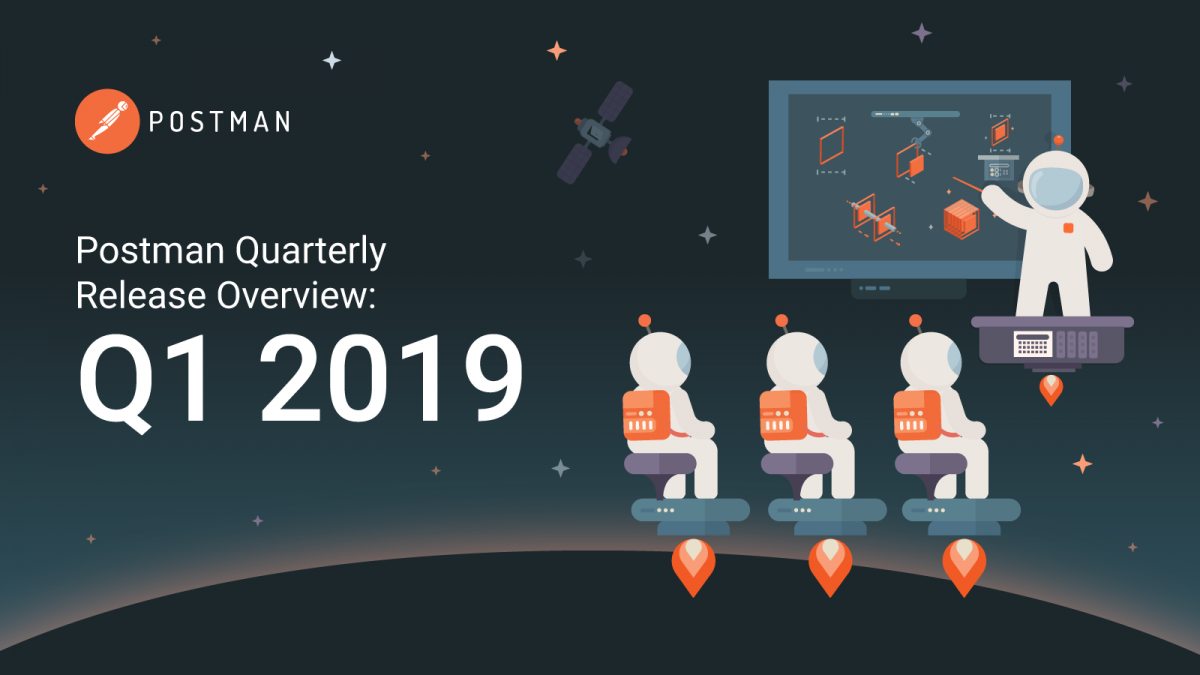Postman Quarterly Release Overview: Q1 2019
At Postman, we’re constantly pushing releases; in fact, over the last year, Postman has averaged a new release nearly every two working days. While many of these releases were under the hood, bug fixes and other small updates, many were high impact. 2018 was a big year for Postman: we made teams available to free users, launched a Postman Enterprise plan, and released Postman Workspaces and Sessions. Every release is intended to be a step forward for simplifying API development for our current and future users.
2019 is shaping out to be another big year for us! As Q2 gets going, let’s review what’s come out in Q1:
OpenAPI 3.0 Support
We added support for importing OpenAPI specifications! This was one of the most requested features from our community and we wanted to resurface this feature for anyone who missed out. Supporting OpenAPI 3.0 was our first step toward enabling greater flexibility to work with different specs and formats within Postman.
Check out this blog post that walks through converting OpenAPI specs to Postman collections by Abhijit Kane, one of our co-founders. And for those of you who will inevitably ask, GraphQL support is on the way. Check out our public roadmap to see which other features we have in development.
In-App Postman Bootcamp Lessons
We added interactive lessons *inside* the Postman app. We wanted to show off the multitude of other things Postman can do, so we built out a library of interactive lessons where users of all levels can explore Postman. These lessons help users familiarize themselves with Postman and build skills in a guided, hands-on environment.
We currently offer lessons about designing and mocking APIs, debugging and manual testing, automated testing, API documentation, monitoring, and collaboration and we’re constantly adding new lessons – so check them out!
Learn more about Postman Bootcamp lessons.
Postman Live Online Training Courses
If you’re the type of person who learns best from an instructor, we have you covered: we recently launched, live, online Postman training courses. Each course is affordable, three hours long, and led by a live instructor. We currently offer a Postman Fundamentals course as well as a Postman Expert course, and we’re adding more soon!
Sign-up for a Postman training course with your team.
GitHub and GitLab Integration
We added a new GitHub and GitLab integration for Postman Pro and Postman Enterprise to make it easier to sync Postman with Git repositories. Postman Pro and Enterprise teams are able to backup and synchronize their collections on custom domains and view backed-up collections in their GitLab repositories. We’ll be building out more integrations in the future, so stay tuned.
Learn more about Postman’s GitHub integration and GitLab integration.
Forking + Merging
We added forking + merging in Postman to give teams more control over their collaborative workflows. Forking + merging is similar to branching and merging in version control systems. Forking a Postman Collection within a workspace creates a linked version of that collection that can sync to any teammate’s Postman instance within that workspace.
This added functionality allows users to view the diff, verify changes, resolve conflicts, and merge changes back to their base collection. This allows multiple teammates to work off of different versions of Postman collections in real time.
Learn more about forking + merging in Postman.
Comments
We released commenting in Postman in October, but in Q1 we extended commenting capabilities to better facilitate streamlined communication directly within the Postman app.
Here’s what we added to our commenting capabilities:
- Markdown support so users could style comments.
- Tagging and notifying team members of new comments.
- Automatically syncing of comments to the app from the dashboard.
- Admins control over deleting comments.
Learn more about comments in Postman.
Extended Roles and Permissions
We extended Postman access control to enable more flexible team structures. Postman’s roles and permissions now include roles at the workspace level: Workspace Collaborator and Workspace Admin. So, for those keeping track at home, Postman allows members to be classified by their roles at the collection-level and team-level, and now, at the workspace-level.
Assigning roles and permissions to team members helps keep your team’s workflow organized and ensures that each teammate has a clear role in contributing to API development.
Learn more about Access Control and Extended Roles and Permissions.
And there you have it. If you haven’t played around with these new features, go try them out! We’re excited to continue releasing more features that make API development easier and help promote innovation in API design. We couldn’t do it without our awesome community. Keep sending your suggestions and feedback.

What do you think about this topic? Tell us in a comment below.